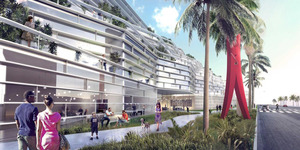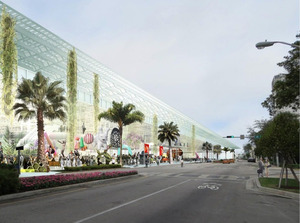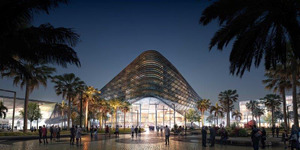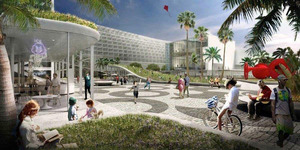The WPJ
THE WORLD PROPERTY JOURNALReal Estate Facts Not Fiction
Featured Columnists

Good Urban Design Losing in Miami Beach
Commercial News » Global Property Beat | By Kevin Brass | July 5, 2013 11:25 AM ET
The battle of the superstar architects in Miami Beach is shaping up as something of a draw. Both architects--as well as good design--are losing to the bureaucrats, who are moving to put their own boring stamp on the project.
 For months separate developer/design teams led by internationally acclaimed architects Rem Koolhaas and Bjarke Ingels have been creating competing visions for the redevelopment of the Miami Beach Convention Center and the surrounding 52-acres in the heart of Miami Beach. The competition for the $1.1 billion project was scheduled to reach a climax later this month, when the city was expected to choose one of the two designs to pursue.
For months separate developer/design teams led by internationally acclaimed architects Rem Koolhaas and Bjarke Ingels have been creating competing visions for the redevelopment of the Miami Beach Convention Center and the surrounding 52-acres in the heart of Miami Beach. The competition for the $1.1 billion project was scheduled to reach a climax later this month, when the city was expected to choose one of the two designs to pursue.Instead, City Manager Jimmy Morales this week announced the city might ditch the entire process. Mr. Morales proposed a radical downsizing, removing residential units from the plan and decreasing the retail space, in favor of a stripped-down convention center and hotel project.
In other words, Miami Beach invited top developers and designers to town and now they're going to show them a little small town urban planning, Florida style. They appreciate all that smart talk and fancy drawings, but they've decided, gosh darn, that's not what they want, after all.
 The developers and design teams were given a deadline to decide if they want to continue.
The developers and design teams were given a deadline to decide if they want to continue.Why would they? Good urban planning requires bold ideas, clear directions and experienced hands. Miami Beach is illustrating none of the above by radically shifting the ground rules after months of planning and debate.
Even before this latest twist, there were rumblings that the city was uncomfortable with the bold plans presented by the out-of-towners.
In the Miami Herald, architecture writer Beth Dunlop argued that the city should take more control of the planning process.
"To ask private developers to create a plan that will transform a truly critical swathe of the city, of public land, is in many ways an abrogation of governmental responsibility and one of the better examples of cart-before-the-horse urban planning in our recent history," she wrote.
In many ways, that is, of course, completely wrong.
Letting the various amateur city committees and community special interest groups dictate the specifics of a project is almost the definition of design by committee, guaranteeing the creation of bland swatches that interest few and offend no one.
City officials are not visionaries. Some can barely spell, as far as the public can tell. Nor do they have a particularly good track record on representing the public's interest. They are politicians and bureaucrats.
Good urban design requires the politicians and bureaucrats to set the parameters and then get out of the way. If the end of the process is a public vote, so be it. Let the public decide. But the city's role is to allow the experts to create a vision, within the established guidelines.
 In cities around the world, great urban settings were created by strong civic leaders who understood this process. They cut through the bureaucracies and embraced the ideas of architects and designers. Public input was frontloaded into the process, insuring that the developers and architects understood the community's interests. The bureaucrats' role was to move the creative process away from the blizzard of special interests and braying NIMBYs.
In cities around the world, great urban settings were created by strong civic leaders who understood this process. They cut through the bureaucracies and embraced the ideas of architects and designers. Public input was frontloaded into the process, insuring that the developers and architects understood the community's interests. The bureaucrats' role was to move the creative process away from the blizzard of special interests and braying NIMBYs. Designers should be allowed to design. That's what they do. Let the artists create spaces and buildings that excite and transform cities. Give them clear goals and guidelines and then let them use their talent.
That's not how Miami Beach is doing it. They are offering muddled messages, unclear direction and repeated warnings that they don't really know what they want for the site.
 If city leaders didn't like the plans proposed by Koolhaas and Ingels, no problem. Clearly city leaders are balking at giving away too much to private developers in a public project. That's understandable--a little late in the game, but understandable.
If city leaders didn't like the plans proposed by Koolhaas and Ingels, no problem. Clearly city leaders are balking at giving away too much to private developers in a public project. That's understandable--a little late in the game, but understandable.But now they've changed the basic concepts and any new design will be hamstrung by the simplistic guidelines and the mistakes of the past. They are removing the opportunity for creativity and vision. Taking out the ambition won't make it a better project, only a smaller project.
Miami Beach is providing a textbook example of how not to create a great urban space. They are moving away from innovation and big picture thinking and stumbling toward a project that will simply be a "redesign of a convention center," a marginal improvement for the city and nothing more. That's what happens when you let the bureaucrats lead urban design efforts.
Note: WPC Editor Kevin Brass lives in Miami Beach.
Proposal from South Beach ACE, the team led by Tishman Realty, developer Robert Wennett and architect Rem Koolhaas' OMA:
Proposal from Portman CMC, the team led by the Atlanta-based John Portman & Associates and architect Bjarke Ingel's BIG:
Sign Up Free | The WPJ Weekly Newsletter
Relevant real estate news.
Actionable market intelligence.
Right to your inbox every week.
Real Estate Listings Showcase
Related News Stories
Featured Columnists Real Estate Headlines
- 2025 Prediction: U.S. Commercial Investment Recovery Expected to Gain Traction
- Holiday Retail Sales for 2024 to Hit Record $1 Trillion
- Tech, AI Industries Drive Largest Share of Office Leasing Activity in U.S.
- Commercial Real Estate Lending in U.S. Enjoys Strong Growth in Q3
- U.S. Multifamily Market Begins Recovery in Q3
- Commercial Investment in Japan Spikes 24 Percent Annually in Q3
- Despite Return-to-Office Mandates, U.S. Office Vacancies Continue to Rise
- PROPSIG Tech Startup Acquired by World Property Data
- U.S. Commercial Mortgage Debt Hits $4.7 Trillion in Q2 as Delinquencies Increase
- Hong Kong Class A Office Rents Continue to Downtick in Mid-Summer
- U.S. Office Landlords Tenant Concessions Decline for First Time in 4 Years
- U.S. Commercial Mortgage Originations Spike 27 Percent in Q2 Over Q1
- Phnom Penh's Commercial Office, Retail Markets Face Slowdowns in 2024
- Global Edge Data Center Market to Hit $300 Billion by 2026
- Commercial Property Transactions in Japan Dive 25 Percent Annually in Q2
- Delinquency Rates for U.S. Commercial Property Loans Downticks in Q2
- Megawarehouse Lease Deals in U.S. Increase in 2024
- Office Tenants' Flight to Quality Buildings Increases in 2024
- Commercial Lending in Japan Upticks 6 Percent Annually in Q1
- AI Driving Significant Global Data Center Growth in 2024
- Total U.S. Commercial Mortgage Debt Rises to $4.7 Trillion in Q1
- U.S. Commercial Mortgage Delinquencies Rise in Early 2024
- Asia Pacific Office Sector to Further Reprice Throughout 2024
- U.S. Retail Foot Traffic to Surpass Pre-Pandemic Levels by 2025
- Commercial Real Estate Lending in U.S. Slowed in First Quarter
- Japan Commercial Property Investment Volume Jumps 7 Percent in Q1
- Asia Pacific Commercial Property Investment Leads the World, Spikes 13 Percent
- Driven by High Rates, U.S. Commercial Lending Imploded 47 Percent in 2023
- After Two Year Slump, Prime Multifamily Metrics Uptick in U.S.
- Commercial Co-Broker Commissions Not Affected by NAR-DOJ Settlement, Yet
- U.S. Office Buildings with Upscale Tenant Amenities Still Enjoy Premium Rents in 2024
- U.S. Commercial, Multifamily Mortgage Delinquency Rates Uptick in Q4
- U.S. Commercial Mortgage Debt Continued to Rise in 2023, Hits $4.7 Trillion
- Nonresidential Construction Spending in the U.S. Falls Sharply in January
- U.S. Multifamily Construction Starts to Decline in 2024
- Commercial Mortgage Lending in U.S. Shows Signs of Stabilization in Late 2023
- Architecture Billings Decline in December as Soft Business Conditions Persist
- Government Sector Claimed Largest Portion of 100 Biggest U.S. Office Leases Signed in 2023
- U.S. Commercial, Multifamily Borrowing Dives 25 Percent Annually in Late 2023
- Record High Multifamily Construction Deliveries Drive Vacancy Rates Higher
Reader Poll
Marketplace Links
This website uses cookies to improve user experience. By using our website you consent in accordance with our Cookie Policy. Read More





